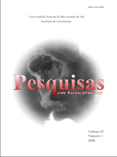Protocolo Tafonômico/Paleoautoecológico com Ferramenta nas Análises Paleossinecológicas de Invertebrados: Exemplos de Alpicação em Concentrações Fossilíferas do Paleozóico da Bacia do Paraná, Brasil
DOI:
https://doi.org/10.22456/1807-9806.20186Palavras-chave:
paleoecology, taphonomy, time-averagingResumo
Paleoecology is a discipline that deals with interactions of fossil organisms in their ancient environments. Intrinsically, all paleoecologic interpretations require information on the time resolution of individual samples (hours, days, months, years, centuries). However, one of the major obstacles in dealing with any form of data derived from fossil collections is the effects of time-averaging, which are the result of mixing the remains of organisms that did not lived together. In other words: individual fossils found preserved together in a given geological strata are not necessarily contemporaneous, influencing the paleossinecologic conclusions. Here a seven steps taphonomic/autoecologic protocol is proposed in order to standers some field (e.g., collecting) and laboratory procedures. The protocol emphasizes the need for the recognizance of the time-averaging phenomena in a given paleontologic collection. This is particularly true for the Paleozoic fossil concentration where an absolute age of the bioclasts can not be obtained by radiometric dating. For paleoecologic purposes sampling size must be large and precise enough (bed-to-bed) to generate collections including the full range of taphonomic signatures showed by each individual fossil from the same bedding plane. A sampling strategy of large oriented blocks (0,05 m3) is here proposed, but this collecting methodology seems to be more appropriated applicable for fossil accumulations, such as the internally complex concentrations (e.g., bioclastic sandstones and coquinas) represented by tridimensional bodies that are easily recognized in the geological record.



